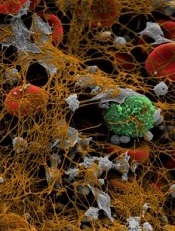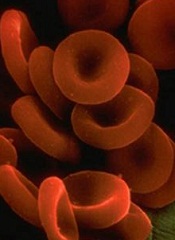User login
Collaborative Care, Part 1: The move toward collaborative care
Neil Kirschner, Ph.D., senior associate for health policy and regulatory affairs for the American College of Physicians, explains why the solo practitioner model of health care needs to give way to collaborative care. “Care is turning into a team-based approach [that] allows you to have staff to provide effective integration of care, but to have a team, you need funding,” he says. “One-third of our health care spending is on ‘wasted care’ … [and that money] could be leveraged toward providing effective care.”
The video associated with this article is no longer available on this site. Please view all of our videos on the MDedge YouTube channel
Neil Kirschner, Ph.D., senior associate for health policy and regulatory affairs for the American College of Physicians, explains why the solo practitioner model of health care needs to give way to collaborative care. “Care is turning into a team-based approach [that] allows you to have staff to provide effective integration of care, but to have a team, you need funding,” he says. “One-third of our health care spending is on ‘wasted care’ … [and that money] could be leveraged toward providing effective care.”
The video associated with this article is no longer available on this site. Please view all of our videos on the MDedge YouTube channel
Neil Kirschner, Ph.D., senior associate for health policy and regulatory affairs for the American College of Physicians, explains why the solo practitioner model of health care needs to give way to collaborative care. “Care is turning into a team-based approach [that] allows you to have staff to provide effective integration of care, but to have a team, you need funding,” he says. “One-third of our health care spending is on ‘wasted care’ … [and that money] could be leveraged toward providing effective care.”
The video associated with this article is no longer available on this site. Please view all of our videos on the MDedge YouTube channel
Poorer survival of African Americans with kidney cancer may be due to genomic differences
SAN FRANCISCO – African American patients with clear-cell renal cell carcinoma may have poorer survival in part because of genomic factors that render tumors more aggressive and less sensitive to anti-angiogenic therapy, suggests a study reported at the Genitourinary Cancers Symposium.
Genomic analysis in 438 patients with metastatic disease found that African Americans were about half as likely as Caucasians to have mutations of the von Hippel–Lindau (VHL) tumor suppressor gene, reported lead investigator Dr. Tracy Lynn Rose, a hematology-oncology fellow at the University of North Carolina at Chapel Hill and Lineberger Comprehensive Cancer Center. Mutational inactivation of this gene leads to increased signaling in the vascular endothelial growth factor (VEGF) pathway.
African Americans also were more likely to have the clear cell B molecular subtype and had less up-regulation of pathways associated with hypoxia-inducible factor (HIF), which collectively suggest a less angiogenic profile and activation of non-VEGF pathways.
A companion analysis of 35,152 patients treated during a 14-year period found that African American patients with metastatic renal cell carcinoma still had a higher risk of death than white peers in the contemporary era, after introduction of multiple agents that target the VEGF pathway and similar increases in receipt of systemic therapy.
“Our findings indicate clear differences in the biology of clear-cell renal cell carcinoma between African Americans and Caucasians. These differences could suggest a larger proportion of tumors from African Americans have a HIF- and VEGF-independent propensity for aggressiveness, and they also suggest perhaps increased resistance of African Americans to VEGF-targeted therapy,” Dr. Rose said at the symposium, sponsored by the American Society of Clinical Oncology, ASTRO, and the Society of Urologic Oncology.
“Overall, our data lend support to a role for tumor biology in the survival disparity observed between African American and Caucasian patients,” she said.
The study may be a step toward precision medicine, whereby race is used to guide treatment decisions, according to invited discussant Dr. Guru Sonpavde, director of the Genitourinary Malignancy Program at the University of Alabama at Birmingham. “That’s an exciting possibility,” he said.
“It is plausible that African American patients are less VEGF driven, less responsive to VEGF inhibitors, but I think the results right now are not ready for use in the clinic,” he further commented. “We need validation in a larger number of African American patients. But even more importantly, we need to focus more on molecular measures of VEGF-driven tumors, to select patients for VEGF inhibitors since we don’t have any biomarkers of this sort in the clinic today.”
“Finally, somatic differences may be driven by differences in the germline, and we may want to focus on integrating the germline and somatic alterations into a molecular panel which might be even better at predicting benefit from specific agents,” he concluded.
Previous studies have found a small but consistent elevation of the risk of death for African American patients with renal cell carcinoma, Dr. Rose noted when introducing the study. Initial hypotheses were that this disparity might be due to differences in comorbidities and use of nephrectomy.
She and her colleagues performed genomic analyses in a discovery cohort of 438 African American and Caucasian patients with metastatic clear-cell renal cell carcinoma from The Cancer Genome Atlas database.
Results indicated that African Americans in this discovery cohort were less likely to have a VHL mutation (17% vs. 50%, P = .036), a finding that was confirmed in a validation cohort of 135 similar patients (40% vs. 81%, P = .008).
African American patients were less likely to have several VEGF and HIF signatures relative to Caucasian counterparts. On the other hand, they were more likely to have the clear cell B molecular subtype (79% vs. 45%, P less than .01), which has been associated with decreased activation of angiogenic pathways and poorer prognosis.
The investigators next analyzed data from the National Cancer Database, assessing survival among 35,152 patients who received a diagnosis of metastatic clear-cell renal cell carcinoma between 1998 and 2011.
The proportion receiving systemic therapy over time was similar for African American and Caucasian patients, with both seeing a rise in 2006, corresponding to the introduction of VEGF-targeted therapies. The poorer median survival for African American versus Caucasian patients seen during 1998-2004 (6.0 vs. 7.6 months; adjusted hazard ratio, 1.07; P less than .01) was still evident in 2006-2011 (6.5 vs. 9.2 months; adjusted hazard ratio, 1.08; P less than .01).
SAN FRANCISCO – African American patients with clear-cell renal cell carcinoma may have poorer survival in part because of genomic factors that render tumors more aggressive and less sensitive to anti-angiogenic therapy, suggests a study reported at the Genitourinary Cancers Symposium.
Genomic analysis in 438 patients with metastatic disease found that African Americans were about half as likely as Caucasians to have mutations of the von Hippel–Lindau (VHL) tumor suppressor gene, reported lead investigator Dr. Tracy Lynn Rose, a hematology-oncology fellow at the University of North Carolina at Chapel Hill and Lineberger Comprehensive Cancer Center. Mutational inactivation of this gene leads to increased signaling in the vascular endothelial growth factor (VEGF) pathway.
African Americans also were more likely to have the clear cell B molecular subtype and had less up-regulation of pathways associated with hypoxia-inducible factor (HIF), which collectively suggest a less angiogenic profile and activation of non-VEGF pathways.
A companion analysis of 35,152 patients treated during a 14-year period found that African American patients with metastatic renal cell carcinoma still had a higher risk of death than white peers in the contemporary era, after introduction of multiple agents that target the VEGF pathway and similar increases in receipt of systemic therapy.
“Our findings indicate clear differences in the biology of clear-cell renal cell carcinoma between African Americans and Caucasians. These differences could suggest a larger proportion of tumors from African Americans have a HIF- and VEGF-independent propensity for aggressiveness, and they also suggest perhaps increased resistance of African Americans to VEGF-targeted therapy,” Dr. Rose said at the symposium, sponsored by the American Society of Clinical Oncology, ASTRO, and the Society of Urologic Oncology.
“Overall, our data lend support to a role for tumor biology in the survival disparity observed between African American and Caucasian patients,” she said.
The study may be a step toward precision medicine, whereby race is used to guide treatment decisions, according to invited discussant Dr. Guru Sonpavde, director of the Genitourinary Malignancy Program at the University of Alabama at Birmingham. “That’s an exciting possibility,” he said.
“It is plausible that African American patients are less VEGF driven, less responsive to VEGF inhibitors, but I think the results right now are not ready for use in the clinic,” he further commented. “We need validation in a larger number of African American patients. But even more importantly, we need to focus more on molecular measures of VEGF-driven tumors, to select patients for VEGF inhibitors since we don’t have any biomarkers of this sort in the clinic today.”
“Finally, somatic differences may be driven by differences in the germline, and we may want to focus on integrating the germline and somatic alterations into a molecular panel which might be even better at predicting benefit from specific agents,” he concluded.
Previous studies have found a small but consistent elevation of the risk of death for African American patients with renal cell carcinoma, Dr. Rose noted when introducing the study. Initial hypotheses were that this disparity might be due to differences in comorbidities and use of nephrectomy.
She and her colleagues performed genomic analyses in a discovery cohort of 438 African American and Caucasian patients with metastatic clear-cell renal cell carcinoma from The Cancer Genome Atlas database.
Results indicated that African Americans in this discovery cohort were less likely to have a VHL mutation (17% vs. 50%, P = .036), a finding that was confirmed in a validation cohort of 135 similar patients (40% vs. 81%, P = .008).
African American patients were less likely to have several VEGF and HIF signatures relative to Caucasian counterparts. On the other hand, they were more likely to have the clear cell B molecular subtype (79% vs. 45%, P less than .01), which has been associated with decreased activation of angiogenic pathways and poorer prognosis.
The investigators next analyzed data from the National Cancer Database, assessing survival among 35,152 patients who received a diagnosis of metastatic clear-cell renal cell carcinoma between 1998 and 2011.
The proportion receiving systemic therapy over time was similar for African American and Caucasian patients, with both seeing a rise in 2006, corresponding to the introduction of VEGF-targeted therapies. The poorer median survival for African American versus Caucasian patients seen during 1998-2004 (6.0 vs. 7.6 months; adjusted hazard ratio, 1.07; P less than .01) was still evident in 2006-2011 (6.5 vs. 9.2 months; adjusted hazard ratio, 1.08; P less than .01).
SAN FRANCISCO – African American patients with clear-cell renal cell carcinoma may have poorer survival in part because of genomic factors that render tumors more aggressive and less sensitive to anti-angiogenic therapy, suggests a study reported at the Genitourinary Cancers Symposium.
Genomic analysis in 438 patients with metastatic disease found that African Americans were about half as likely as Caucasians to have mutations of the von Hippel–Lindau (VHL) tumor suppressor gene, reported lead investigator Dr. Tracy Lynn Rose, a hematology-oncology fellow at the University of North Carolina at Chapel Hill and Lineberger Comprehensive Cancer Center. Mutational inactivation of this gene leads to increased signaling in the vascular endothelial growth factor (VEGF) pathway.
African Americans also were more likely to have the clear cell B molecular subtype and had less up-regulation of pathways associated with hypoxia-inducible factor (HIF), which collectively suggest a less angiogenic profile and activation of non-VEGF pathways.
A companion analysis of 35,152 patients treated during a 14-year period found that African American patients with metastatic renal cell carcinoma still had a higher risk of death than white peers in the contemporary era, after introduction of multiple agents that target the VEGF pathway and similar increases in receipt of systemic therapy.
“Our findings indicate clear differences in the biology of clear-cell renal cell carcinoma between African Americans and Caucasians. These differences could suggest a larger proportion of tumors from African Americans have a HIF- and VEGF-independent propensity for aggressiveness, and they also suggest perhaps increased resistance of African Americans to VEGF-targeted therapy,” Dr. Rose said at the symposium, sponsored by the American Society of Clinical Oncology, ASTRO, and the Society of Urologic Oncology.
“Overall, our data lend support to a role for tumor biology in the survival disparity observed between African American and Caucasian patients,” she said.
The study may be a step toward precision medicine, whereby race is used to guide treatment decisions, according to invited discussant Dr. Guru Sonpavde, director of the Genitourinary Malignancy Program at the University of Alabama at Birmingham. “That’s an exciting possibility,” he said.
“It is plausible that African American patients are less VEGF driven, less responsive to VEGF inhibitors, but I think the results right now are not ready for use in the clinic,” he further commented. “We need validation in a larger number of African American patients. But even more importantly, we need to focus more on molecular measures of VEGF-driven tumors, to select patients for VEGF inhibitors since we don’t have any biomarkers of this sort in the clinic today.”
“Finally, somatic differences may be driven by differences in the germline, and we may want to focus on integrating the germline and somatic alterations into a molecular panel which might be even better at predicting benefit from specific agents,” he concluded.
Previous studies have found a small but consistent elevation of the risk of death for African American patients with renal cell carcinoma, Dr. Rose noted when introducing the study. Initial hypotheses were that this disparity might be due to differences in comorbidities and use of nephrectomy.
She and her colleagues performed genomic analyses in a discovery cohort of 438 African American and Caucasian patients with metastatic clear-cell renal cell carcinoma from The Cancer Genome Atlas database.
Results indicated that African Americans in this discovery cohort were less likely to have a VHL mutation (17% vs. 50%, P = .036), a finding that was confirmed in a validation cohort of 135 similar patients (40% vs. 81%, P = .008).
African American patients were less likely to have several VEGF and HIF signatures relative to Caucasian counterparts. On the other hand, they were more likely to have the clear cell B molecular subtype (79% vs. 45%, P less than .01), which has been associated with decreased activation of angiogenic pathways and poorer prognosis.
The investigators next analyzed data from the National Cancer Database, assessing survival among 35,152 patients who received a diagnosis of metastatic clear-cell renal cell carcinoma between 1998 and 2011.
The proportion receiving systemic therapy over time was similar for African American and Caucasian patients, with both seeing a rise in 2006, corresponding to the introduction of VEGF-targeted therapies. The poorer median survival for African American versus Caucasian patients seen during 1998-2004 (6.0 vs. 7.6 months; adjusted hazard ratio, 1.07; P less than .01) was still evident in 2006-2011 (6.5 vs. 9.2 months; adjusted hazard ratio, 1.08; P less than .01).
AT THE GENITOURINARY CANCERS SYMPOSIUM
Key clinical point: The poorer survival of African American patients vs. Caucasian patients with clear-cell renal cell carcinoma may be due in part to genomic factors.
Major finding: Compared with Caucasian patients, African American patients were less likely to have mutations of the VHL gene (17% vs. 50%) and more likely to have the clear cell B molecular subtype (79% vs. 45%).
Data source: Analyses of a genomic cohort of 438 patients with metastatic clear-cell renal cell carcinoma from The Cancer Genome Atlas database and a survival cohort of 35,152 from the National Cancer Database.
Disclosures: Dr. Rose disclosed that she had no relevant conflicts of interest. Dr. Sonpavde disclosed that he has a consulting or advisory role with Bayer, Genentech, Merck, Novartis, Pfizer, and Sanofi, and that his institution receives research funding from Bayer, Boehringer Ingelheim, and Onyx.
NSAIDs for UTI
Urinary tract infections (UTIs) unfortunately present an abundant opportunity for us to reflexively and mindlessly contribute to filling up the globe with multidrug resistant bacteria. Many of us have patients with recurrent UTIs, who, despite our best efforts at trying to reduce recurrence through non–medication approaches, frequently call for treatment. We stand by helplessly as we watch the resistance of these organisms increase.
Is there another way?
Investigators in Germany evaluated the benefit and harms of prescribing ibuprofen in place of an antibiotic in women with symptoms of a UTI and no risk factors (BMC Med. 2010 May 26;8:30). Women aged 18-65 years were randomized to a single dose of the broad-spectrum antibiotic fosfomycin 3 g (n = 246) or ibuprofen three 400-mg doses (n = 248) for 3 days. Patients were excluded if they had any signs of upper urinary tract infection, pregnancy, urinary catheterization, gastrointestinal ulcers, or chronic conditions. Antibiotics were prescribed for persistent, worsening, or recurrent symptoms.
Women in the ibuprofen group received significantly fewer antibiotic prescriptions (283 in the fosfomycin group and 94 in the ibuprofen group; incidence rate reduction of 66.5%; 95% confidence interval, 58.8%-74.4%; P less than .001). The ibuprofen group had more symptoms that lasted a day longer. On day 4, 56% of women in the fosfomycin vs. 39% of participants in the ibuprofen group were symptom free, which increased to 82% and 70% by day 7. The ibuprofen group were more likely to develop pyelonephritis (five cases in the ibuprofen group and one in the fosfomycin group; P = .12), but all women were treated and recovered fully. Four events led to “hospital referrals,” only one of which was related to trial drug (gastrointestinal hemorrhage).
In summary, two-thirds of women in the ibuprofen group recovered without antibiotic treatment and one-third received antibiotics for persistent or worsening symptoms. The authors concluded that ibuprofen was inferior to fosfomycin for initial symptomatic treatment. The nonstatistically higher rate of upper urinary tract infection with ibuprofen may make some clinicians nervous.
However, perhaps this is worth exploring for select patients with mild symptoms. The investigators mention data suggesting women may be aware of disadvantages of antibiotics and may be open to the idea of delaying or avoiding treatment, which opens the door to informed discussions. I am planning to discuss it with my patient who has frequent UTIs to see if we can delay intravenous antibiotics for UTI. Intravenous antibiotics for UTI make me uncomfortable for a variety of reasons.
Dr. Ebbert is professor of medicine, a general internist at the Mayo Clinic in Rochester, Minn., and a diplomate of the American Board of Addiction Medicine. The opinions expressed are those of the author and do not necessarily represent the views and opinions of the Mayo Clinic. The opinions expressed in this article should not be used to diagnose or treat any medical condition nor should they be used as a substitute for medical advice from a qualified, board-certified practicing clinician. Dr. Ebbert has no relevant financial disclosures about this article.
Urinary tract infections (UTIs) unfortunately present an abundant opportunity for us to reflexively and mindlessly contribute to filling up the globe with multidrug resistant bacteria. Many of us have patients with recurrent UTIs, who, despite our best efforts at trying to reduce recurrence through non–medication approaches, frequently call for treatment. We stand by helplessly as we watch the resistance of these organisms increase.
Is there another way?
Investigators in Germany evaluated the benefit and harms of prescribing ibuprofen in place of an antibiotic in women with symptoms of a UTI and no risk factors (BMC Med. 2010 May 26;8:30). Women aged 18-65 years were randomized to a single dose of the broad-spectrum antibiotic fosfomycin 3 g (n = 246) or ibuprofen three 400-mg doses (n = 248) for 3 days. Patients were excluded if they had any signs of upper urinary tract infection, pregnancy, urinary catheterization, gastrointestinal ulcers, or chronic conditions. Antibiotics were prescribed for persistent, worsening, or recurrent symptoms.
Women in the ibuprofen group received significantly fewer antibiotic prescriptions (283 in the fosfomycin group and 94 in the ibuprofen group; incidence rate reduction of 66.5%; 95% confidence interval, 58.8%-74.4%; P less than .001). The ibuprofen group had more symptoms that lasted a day longer. On day 4, 56% of women in the fosfomycin vs. 39% of participants in the ibuprofen group were symptom free, which increased to 82% and 70% by day 7. The ibuprofen group were more likely to develop pyelonephritis (five cases in the ibuprofen group and one in the fosfomycin group; P = .12), but all women were treated and recovered fully. Four events led to “hospital referrals,” only one of which was related to trial drug (gastrointestinal hemorrhage).
In summary, two-thirds of women in the ibuprofen group recovered without antibiotic treatment and one-third received antibiotics for persistent or worsening symptoms. The authors concluded that ibuprofen was inferior to fosfomycin for initial symptomatic treatment. The nonstatistically higher rate of upper urinary tract infection with ibuprofen may make some clinicians nervous.
However, perhaps this is worth exploring for select patients with mild symptoms. The investigators mention data suggesting women may be aware of disadvantages of antibiotics and may be open to the idea of delaying or avoiding treatment, which opens the door to informed discussions. I am planning to discuss it with my patient who has frequent UTIs to see if we can delay intravenous antibiotics for UTI. Intravenous antibiotics for UTI make me uncomfortable for a variety of reasons.
Dr. Ebbert is professor of medicine, a general internist at the Mayo Clinic in Rochester, Minn., and a diplomate of the American Board of Addiction Medicine. The opinions expressed are those of the author and do not necessarily represent the views and opinions of the Mayo Clinic. The opinions expressed in this article should not be used to diagnose or treat any medical condition nor should they be used as a substitute for medical advice from a qualified, board-certified practicing clinician. Dr. Ebbert has no relevant financial disclosures about this article.
Urinary tract infections (UTIs) unfortunately present an abundant opportunity for us to reflexively and mindlessly contribute to filling up the globe with multidrug resistant bacteria. Many of us have patients with recurrent UTIs, who, despite our best efforts at trying to reduce recurrence through non–medication approaches, frequently call for treatment. We stand by helplessly as we watch the resistance of these organisms increase.
Is there another way?
Investigators in Germany evaluated the benefit and harms of prescribing ibuprofen in place of an antibiotic in women with symptoms of a UTI and no risk factors (BMC Med. 2010 May 26;8:30). Women aged 18-65 years were randomized to a single dose of the broad-spectrum antibiotic fosfomycin 3 g (n = 246) or ibuprofen three 400-mg doses (n = 248) for 3 days. Patients were excluded if they had any signs of upper urinary tract infection, pregnancy, urinary catheterization, gastrointestinal ulcers, or chronic conditions. Antibiotics were prescribed for persistent, worsening, or recurrent symptoms.
Women in the ibuprofen group received significantly fewer antibiotic prescriptions (283 in the fosfomycin group and 94 in the ibuprofen group; incidence rate reduction of 66.5%; 95% confidence interval, 58.8%-74.4%; P less than .001). The ibuprofen group had more symptoms that lasted a day longer. On day 4, 56% of women in the fosfomycin vs. 39% of participants in the ibuprofen group were symptom free, which increased to 82% and 70% by day 7. The ibuprofen group were more likely to develop pyelonephritis (five cases in the ibuprofen group and one in the fosfomycin group; P = .12), but all women were treated and recovered fully. Four events led to “hospital referrals,” only one of which was related to trial drug (gastrointestinal hemorrhage).
In summary, two-thirds of women in the ibuprofen group recovered without antibiotic treatment and one-third received antibiotics for persistent or worsening symptoms. The authors concluded that ibuprofen was inferior to fosfomycin for initial symptomatic treatment. The nonstatistically higher rate of upper urinary tract infection with ibuprofen may make some clinicians nervous.
However, perhaps this is worth exploring for select patients with mild symptoms. The investigators mention data suggesting women may be aware of disadvantages of antibiotics and may be open to the idea of delaying or avoiding treatment, which opens the door to informed discussions. I am planning to discuss it with my patient who has frequent UTIs to see if we can delay intravenous antibiotics for UTI. Intravenous antibiotics for UTI make me uncomfortable for a variety of reasons.
Dr. Ebbert is professor of medicine, a general internist at the Mayo Clinic in Rochester, Minn., and a diplomate of the American Board of Addiction Medicine. The opinions expressed are those of the author and do not necessarily represent the views and opinions of the Mayo Clinic. The opinions expressed in this article should not be used to diagnose or treat any medical condition nor should they be used as a substitute for medical advice from a qualified, board-certified practicing clinician. Dr. Ebbert has no relevant financial disclosures about this article.
Bert B. Vargas, MD
AHA: Poor real-world adherence to NOACs
ORLANDO – Adherence to the novel oral anticoagulants (NOACs) is surprisingly poor in clinical practice, Xiaoxi Yao, Ph.D., reported at the American Heart Association scientific sessions.
Her retrospective study of nearly 65,000 patients with atrial fibrillation who initiated therapy with apixaban, dabigatran, rivaroxaban, or warfarin showed that during a median 1.1 years of follow-up fewer than half of all patients were treatment adherent, with adherence defined as possession of sufficient medication to cover at least 80% of days.
Adherence rates, while uniformly suboptimal, nevertheless varied considerably: lowest at 38.5% for dabigatran, followed by 40.2% for warfarin, 50.5% for rivaroxaban, and 61.9% for apixaban.
This poor adherence to NOACs in real-world clinical practice is surprising in light of the drugs’ greater convenience, with fewer drug interactions than warfarin and no need for laboratory monitoring, observed Dr. Yao of the Mayo Clinic in Rochester, Minn.
It’s possible, although speculative, that the NOACs’ greater convenience paradoxically contributes to the low adherence rates, since unlike warfarin, NOACs don’t require regular interactions with the health care system for INR monitoring. And then there is the hefty cost of the novel agents, she added.
The study population consisted of 3,900 patients with atrial fibrillation who initiated oral anticoagulation with apixaban (Eliquis), 10,235 who started on dabigatran (Pradaxa), 12,366 on rivaroxaban (Xarelto), and 38,190 on warfarin. The analysis utilized claims data from a large U.S. commercial insurance database.
Adherence rates were better among patients with greater stroke risk as reflected by their CHA2DS2-VASc scores. For example, at the high end of the adherence spectrum, the adherence rate for apixaban was 50% in patients with a CHA2DS2-VASc score of 0-1, rising to 62% with a score of 2-3 and 64% with a score of 4 or more. The corresponding adherence rates for dabigatran were 25% in patients with a CHA2DS2-VASc of 0-1, 40% among those with a score of 2-3, and 42% in patients with a score of 4 or higher.
Dr. Yao and coinvestigators were interested in whether lower adherence to oral anticoagulation was associated with worse outcomes. This proved to be the case with regard to stroke rate for patients with a CHA2DS2-VASc score of 2 or more, where a clear dose-response relationship was evident between the event rate and cumulative time off oral anticoagulation during follow-up.
Among patients with a CHA2DS2-VASc of 2 or 3, the stroke rate was nearly twice as high among those off oral anticoagulation for a total of 3-6 months and three times greater if off therapy for more than 6 months than in those with a total time off of less than 1 week. The stroke rate was even higher in patients with a CHA2DS2-VASc of 4 or more who had suboptimal adherence.
An unexpected finding, she continued, was that among patients with a CHA2DS2-VASc score of 2 or more there was no significant relationship between cumulative time off oral anticoagulation and the risk of major bleeding unless they were off treatment for a total of 6 months or more; only then was the major bleeding risk lower than in patients whose total time off therapy was less than a week. Also, one would expect that when patients are off oral anticoagulation they should be at significantly lower risk of intracranial hemorrhage than when on-therapy, but this proved not to be the case.
For patients at substantial stroke risk as indicated by a CHA2DS2-VASc score of at least 2, this finding about off-treatment bleeding risk actually constitutes a good argument for sticking to their medication, in Dr. Yao’s view.
“Physicians and patients often fear bleeding, especially intracranial hemorrhage, but we found that for patients at higher risk for stroke there is little difference in intracranial hemorrhage risk whether you’re on or off of oral anticoagulation. So higher-risk patients should definitely adhere to their medication because of the stroke prevention benefit. However, in low-risk patients with a CHA2DS2-VASc of 0-1, the benefits of oral anticoagulation may not always outweigh the harm,” she said.
Dr. Yao reported having no financial conflicts of interest regarding her study.
ORLANDO – Adherence to the novel oral anticoagulants (NOACs) is surprisingly poor in clinical practice, Xiaoxi Yao, Ph.D., reported at the American Heart Association scientific sessions.
Her retrospective study of nearly 65,000 patients with atrial fibrillation who initiated therapy with apixaban, dabigatran, rivaroxaban, or warfarin showed that during a median 1.1 years of follow-up fewer than half of all patients were treatment adherent, with adherence defined as possession of sufficient medication to cover at least 80% of days.
Adherence rates, while uniformly suboptimal, nevertheless varied considerably: lowest at 38.5% for dabigatran, followed by 40.2% for warfarin, 50.5% for rivaroxaban, and 61.9% for apixaban.
This poor adherence to NOACs in real-world clinical practice is surprising in light of the drugs’ greater convenience, with fewer drug interactions than warfarin and no need for laboratory monitoring, observed Dr. Yao of the Mayo Clinic in Rochester, Minn.
It’s possible, although speculative, that the NOACs’ greater convenience paradoxically contributes to the low adherence rates, since unlike warfarin, NOACs don’t require regular interactions with the health care system for INR monitoring. And then there is the hefty cost of the novel agents, she added.
The study population consisted of 3,900 patients with atrial fibrillation who initiated oral anticoagulation with apixaban (Eliquis), 10,235 who started on dabigatran (Pradaxa), 12,366 on rivaroxaban (Xarelto), and 38,190 on warfarin. The analysis utilized claims data from a large U.S. commercial insurance database.
Adherence rates were better among patients with greater stroke risk as reflected by their CHA2DS2-VASc scores. For example, at the high end of the adherence spectrum, the adherence rate for apixaban was 50% in patients with a CHA2DS2-VASc score of 0-1, rising to 62% with a score of 2-3 and 64% with a score of 4 or more. The corresponding adherence rates for dabigatran were 25% in patients with a CHA2DS2-VASc of 0-1, 40% among those with a score of 2-3, and 42% in patients with a score of 4 or higher.
Dr. Yao and coinvestigators were interested in whether lower adherence to oral anticoagulation was associated with worse outcomes. This proved to be the case with regard to stroke rate for patients with a CHA2DS2-VASc score of 2 or more, where a clear dose-response relationship was evident between the event rate and cumulative time off oral anticoagulation during follow-up.
Among patients with a CHA2DS2-VASc of 2 or 3, the stroke rate was nearly twice as high among those off oral anticoagulation for a total of 3-6 months and three times greater if off therapy for more than 6 months than in those with a total time off of less than 1 week. The stroke rate was even higher in patients with a CHA2DS2-VASc of 4 or more who had suboptimal adherence.
An unexpected finding, she continued, was that among patients with a CHA2DS2-VASc score of 2 or more there was no significant relationship between cumulative time off oral anticoagulation and the risk of major bleeding unless they were off treatment for a total of 6 months or more; only then was the major bleeding risk lower than in patients whose total time off therapy was less than a week. Also, one would expect that when patients are off oral anticoagulation they should be at significantly lower risk of intracranial hemorrhage than when on-therapy, but this proved not to be the case.
For patients at substantial stroke risk as indicated by a CHA2DS2-VASc score of at least 2, this finding about off-treatment bleeding risk actually constitutes a good argument for sticking to their medication, in Dr. Yao’s view.
“Physicians and patients often fear bleeding, especially intracranial hemorrhage, but we found that for patients at higher risk for stroke there is little difference in intracranial hemorrhage risk whether you’re on or off of oral anticoagulation. So higher-risk patients should definitely adhere to their medication because of the stroke prevention benefit. However, in low-risk patients with a CHA2DS2-VASc of 0-1, the benefits of oral anticoagulation may not always outweigh the harm,” she said.
Dr. Yao reported having no financial conflicts of interest regarding her study.
ORLANDO – Adherence to the novel oral anticoagulants (NOACs) is surprisingly poor in clinical practice, Xiaoxi Yao, Ph.D., reported at the American Heart Association scientific sessions.
Her retrospective study of nearly 65,000 patients with atrial fibrillation who initiated therapy with apixaban, dabigatran, rivaroxaban, or warfarin showed that during a median 1.1 years of follow-up fewer than half of all patients were treatment adherent, with adherence defined as possession of sufficient medication to cover at least 80% of days.
Adherence rates, while uniformly suboptimal, nevertheless varied considerably: lowest at 38.5% for dabigatran, followed by 40.2% for warfarin, 50.5% for rivaroxaban, and 61.9% for apixaban.
This poor adherence to NOACs in real-world clinical practice is surprising in light of the drugs’ greater convenience, with fewer drug interactions than warfarin and no need for laboratory monitoring, observed Dr. Yao of the Mayo Clinic in Rochester, Minn.
It’s possible, although speculative, that the NOACs’ greater convenience paradoxically contributes to the low adherence rates, since unlike warfarin, NOACs don’t require regular interactions with the health care system for INR monitoring. And then there is the hefty cost of the novel agents, she added.
The study population consisted of 3,900 patients with atrial fibrillation who initiated oral anticoagulation with apixaban (Eliquis), 10,235 who started on dabigatran (Pradaxa), 12,366 on rivaroxaban (Xarelto), and 38,190 on warfarin. The analysis utilized claims data from a large U.S. commercial insurance database.
Adherence rates were better among patients with greater stroke risk as reflected by their CHA2DS2-VASc scores. For example, at the high end of the adherence spectrum, the adherence rate for apixaban was 50% in patients with a CHA2DS2-VASc score of 0-1, rising to 62% with a score of 2-3 and 64% with a score of 4 or more. The corresponding adherence rates for dabigatran were 25% in patients with a CHA2DS2-VASc of 0-1, 40% among those with a score of 2-3, and 42% in patients with a score of 4 or higher.
Dr. Yao and coinvestigators were interested in whether lower adherence to oral anticoagulation was associated with worse outcomes. This proved to be the case with regard to stroke rate for patients with a CHA2DS2-VASc score of 2 or more, where a clear dose-response relationship was evident between the event rate and cumulative time off oral anticoagulation during follow-up.
Among patients with a CHA2DS2-VASc of 2 or 3, the stroke rate was nearly twice as high among those off oral anticoagulation for a total of 3-6 months and three times greater if off therapy for more than 6 months than in those with a total time off of less than 1 week. The stroke rate was even higher in patients with a CHA2DS2-VASc of 4 or more who had suboptimal adherence.
An unexpected finding, she continued, was that among patients with a CHA2DS2-VASc score of 2 or more there was no significant relationship between cumulative time off oral anticoagulation and the risk of major bleeding unless they were off treatment for a total of 6 months or more; only then was the major bleeding risk lower than in patients whose total time off therapy was less than a week. Also, one would expect that when patients are off oral anticoagulation they should be at significantly lower risk of intracranial hemorrhage than when on-therapy, but this proved not to be the case.
For patients at substantial stroke risk as indicated by a CHA2DS2-VASc score of at least 2, this finding about off-treatment bleeding risk actually constitutes a good argument for sticking to their medication, in Dr. Yao’s view.
“Physicians and patients often fear bleeding, especially intracranial hemorrhage, but we found that for patients at higher risk for stroke there is little difference in intracranial hemorrhage risk whether you’re on or off of oral anticoagulation. So higher-risk patients should definitely adhere to their medication because of the stroke prevention benefit. However, in low-risk patients with a CHA2DS2-VASc of 0-1, the benefits of oral anticoagulation may not always outweigh the harm,” she said.
Dr. Yao reported having no financial conflicts of interest regarding her study.
AT THE AHA SCIENTIFIC SESSIONS
Key clinical point: Adherence to the novel oral anticoagulants by patients with atrial fibrillation is surprisingly poor outside the clinical trial setting.
Major finding: More than half of patients with atrial fibrillation who started on a novel oral anticoagulant were medication adherent less than 80% of the time.
Data source: This was a retrospective study of nearly 65,000 patients with atrial fibrillation who initiated oral anticoagulant therapy and were then followed for a median of 1.1 years.
Disclosures: The presenter reported having no financial conflicts of interest regarding the study.,
Beta-Blockers May Increase Risk of Perioperative MACEs in Patients with Uncomplicated Hypertension
Clinical question: Does taking a perioperative beta-blocker increase the risk of major adverse cardiovascular events (MACEs) and all-cause mortality in low-risk patients with essential hypertension (HTN)?
Background: Guidelines for the use of perioperative beta-blockers are being reevaluated due to concerns about validity of prior studies that supported the use of perioperative beta-blockers. This study sought to evaluate effectiveness and safety of beta-blockers in patients with uncomplicated HTN.
Study design: Observational cohort study.
Setting: Denmark.
Synopsis: This study included 55,320 hypertensive patients using at least two antihypertensive drugs who underwent non-cardiac surgery. Of these, 14,644 patients were treated with a beta-blocker. Patients with secondary cardiovascular conditions, renal disease, or liver disease were excluded; 30-day MACEs and all-cause mortality were analyzed.
In patients treated with a beta-blocker, the incidence of 30-day MACEs was 1.32% compared with 0.84% in the non-beta-blockers group; 30-day mortality in those treated with beta-blocker was 1.9% compared with 1.3% in the non-beta-blocker group. Risk of beta-blocker-associated MACEs was higher in patients 70 and older. Causality cannot be concluded based on observational data.
Bottom line: In patients with uncomplicated HTN, treatment with a beta-blocker may be associated with increased 30-day risk of perioperative MACEs after non-cardiac surgery.
Citation: Jorgensen ME, Hlatky MA, Kober L, et al. Beta-blocker-associated risks in patients with uncomplicated hypertension undergoing noncardiac surgery. JAMA Intern Med. 2015;175(12):1923-1931.
Clinical question: Does taking a perioperative beta-blocker increase the risk of major adverse cardiovascular events (MACEs) and all-cause mortality in low-risk patients with essential hypertension (HTN)?
Background: Guidelines for the use of perioperative beta-blockers are being reevaluated due to concerns about validity of prior studies that supported the use of perioperative beta-blockers. This study sought to evaluate effectiveness and safety of beta-blockers in patients with uncomplicated HTN.
Study design: Observational cohort study.
Setting: Denmark.
Synopsis: This study included 55,320 hypertensive patients using at least two antihypertensive drugs who underwent non-cardiac surgery. Of these, 14,644 patients were treated with a beta-blocker. Patients with secondary cardiovascular conditions, renal disease, or liver disease were excluded; 30-day MACEs and all-cause mortality were analyzed.
In patients treated with a beta-blocker, the incidence of 30-day MACEs was 1.32% compared with 0.84% in the non-beta-blockers group; 30-day mortality in those treated with beta-blocker was 1.9% compared with 1.3% in the non-beta-blocker group. Risk of beta-blocker-associated MACEs was higher in patients 70 and older. Causality cannot be concluded based on observational data.
Bottom line: In patients with uncomplicated HTN, treatment with a beta-blocker may be associated with increased 30-day risk of perioperative MACEs after non-cardiac surgery.
Citation: Jorgensen ME, Hlatky MA, Kober L, et al. Beta-blocker-associated risks in patients with uncomplicated hypertension undergoing noncardiac surgery. JAMA Intern Med. 2015;175(12):1923-1931.
Clinical question: Does taking a perioperative beta-blocker increase the risk of major adverse cardiovascular events (MACEs) and all-cause mortality in low-risk patients with essential hypertension (HTN)?
Background: Guidelines for the use of perioperative beta-blockers are being reevaluated due to concerns about validity of prior studies that supported the use of perioperative beta-blockers. This study sought to evaluate effectiveness and safety of beta-blockers in patients with uncomplicated HTN.
Study design: Observational cohort study.
Setting: Denmark.
Synopsis: This study included 55,320 hypertensive patients using at least two antihypertensive drugs who underwent non-cardiac surgery. Of these, 14,644 patients were treated with a beta-blocker. Patients with secondary cardiovascular conditions, renal disease, or liver disease were excluded; 30-day MACEs and all-cause mortality were analyzed.
In patients treated with a beta-blocker, the incidence of 30-day MACEs was 1.32% compared with 0.84% in the non-beta-blockers group; 30-day mortality in those treated with beta-blocker was 1.9% compared with 1.3% in the non-beta-blocker group. Risk of beta-blocker-associated MACEs was higher in patients 70 and older. Causality cannot be concluded based on observational data.
Bottom line: In patients with uncomplicated HTN, treatment with a beta-blocker may be associated with increased 30-day risk of perioperative MACEs after non-cardiac surgery.
Citation: Jorgensen ME, Hlatky MA, Kober L, et al. Beta-blocker-associated risks in patients with uncomplicated hypertension undergoing noncardiac surgery. JAMA Intern Med. 2015;175(12):1923-1931.
Pharmacist Involvement in Transitional Care Can Reduce Return ED Visits, Inpatient Readmissions
Clinical question: Does pharmacist involvement in transitions of care decrease medication errors (MEs), adverse drug events (ADEs), and 30-day ED visits and inpatient readmissions?
Background: Previous studies show pharmacist involvement in discharge can reduce ADEs and improve patient satisfaction, but there have been inconsistent data on the impact of pharmacist involvement on readmissions, ADEs, and MEs.
Study design: Prospective, randomized, single-period, longitudinal study.
Setting: Northwestern Memorial Hospital, Chicago.
Synopsis: Investigators included 278 patients (137 in study arm, 141 in control arm) in the final analysis. The study arm received intensive pharmacist involvement on admission and discharge, followed by phone calls at three, 14, and 30 days post-discharge. The study arm had lower composite 30-day ED visits and inpatient readmission rates compared to the control group (25% vs. 39%; P=0.001) but did not have lower isolated inpatient readmission rates (20% vs. 24%; P=0.43). ADEs and MEs were not significantly different between the two groups.
This study had extensive exclusion criteria, limiting the patient population to which these results can be applied. It was underpowered, which could have prevented the detection of a significant improvement in readmission rates.
Care transitions are high-risk periods in patient care, and there is benefit to continuity of care of an interdisciplinary team, including pharmacists.
Bottom line: Pharmacist involvement in transitions of care was shown to reduce the composite of ED visits and inpatient readmissions.
Citation: Phatak A, Prusi R, Ward B, et al. Impact of pharmacist involvement in the transitional care of high-risk patients through medication reconciliation, medication education, and postdischarge call-backs (IPITCH Study). J Hosp Med. 2016;11(1):39-44. doi:10.1002/jhm.2493.
Clinical question: Does pharmacist involvement in transitions of care decrease medication errors (MEs), adverse drug events (ADEs), and 30-day ED visits and inpatient readmissions?
Background: Previous studies show pharmacist involvement in discharge can reduce ADEs and improve patient satisfaction, but there have been inconsistent data on the impact of pharmacist involvement on readmissions, ADEs, and MEs.
Study design: Prospective, randomized, single-period, longitudinal study.
Setting: Northwestern Memorial Hospital, Chicago.
Synopsis: Investigators included 278 patients (137 in study arm, 141 in control arm) in the final analysis. The study arm received intensive pharmacist involvement on admission and discharge, followed by phone calls at three, 14, and 30 days post-discharge. The study arm had lower composite 30-day ED visits and inpatient readmission rates compared to the control group (25% vs. 39%; P=0.001) but did not have lower isolated inpatient readmission rates (20% vs. 24%; P=0.43). ADEs and MEs were not significantly different between the two groups.
This study had extensive exclusion criteria, limiting the patient population to which these results can be applied. It was underpowered, which could have prevented the detection of a significant improvement in readmission rates.
Care transitions are high-risk periods in patient care, and there is benefit to continuity of care of an interdisciplinary team, including pharmacists.
Bottom line: Pharmacist involvement in transitions of care was shown to reduce the composite of ED visits and inpatient readmissions.
Citation: Phatak A, Prusi R, Ward B, et al. Impact of pharmacist involvement in the transitional care of high-risk patients through medication reconciliation, medication education, and postdischarge call-backs (IPITCH Study). J Hosp Med. 2016;11(1):39-44. doi:10.1002/jhm.2493.
Clinical question: Does pharmacist involvement in transitions of care decrease medication errors (MEs), adverse drug events (ADEs), and 30-day ED visits and inpatient readmissions?
Background: Previous studies show pharmacist involvement in discharge can reduce ADEs and improve patient satisfaction, but there have been inconsistent data on the impact of pharmacist involvement on readmissions, ADEs, and MEs.
Study design: Prospective, randomized, single-period, longitudinal study.
Setting: Northwestern Memorial Hospital, Chicago.
Synopsis: Investigators included 278 patients (137 in study arm, 141 in control arm) in the final analysis. The study arm received intensive pharmacist involvement on admission and discharge, followed by phone calls at three, 14, and 30 days post-discharge. The study arm had lower composite 30-day ED visits and inpatient readmission rates compared to the control group (25% vs. 39%; P=0.001) but did not have lower isolated inpatient readmission rates (20% vs. 24%; P=0.43). ADEs and MEs were not significantly different between the two groups.
This study had extensive exclusion criteria, limiting the patient population to which these results can be applied. It was underpowered, which could have prevented the detection of a significant improvement in readmission rates.
Care transitions are high-risk periods in patient care, and there is benefit to continuity of care of an interdisciplinary team, including pharmacists.
Bottom line: Pharmacist involvement in transitions of care was shown to reduce the composite of ED visits and inpatient readmissions.
Citation: Phatak A, Prusi R, Ward B, et al. Impact of pharmacist involvement in the transitional care of high-risk patients through medication reconciliation, medication education, and postdischarge call-backs (IPITCH Study). J Hosp Med. 2016;11(1):39-44. doi:10.1002/jhm.2493.
Protein’s role in thrombosis elucidated

Image by Andre E.X. Brown
Preclinical research helps explain how the protein lysyl oxidase (LOX) enhances platelet activation and thrombosis.
Previous studies showed that LOX is overexpressed in pathologies associated with thrombosis, including myeloproliferative neoplasms.
However, it wasn’t clear exactly how LOX leads to thrombosis.
So Shinobu Matsuuras, PhD, of Boston University School of Medicine in Massachusetts, and her colleagues attempted to find out.
The team reported their findings in Blood.
The researchers wanted to determine the role of LOX in thrombosis and platelet function without the compounding influences of other pathologies.
So they generated mice that expressed LOX in wild-type megakaryocytes and platelets—Pf4-Loxtg/tg mice.
These mice had the same number of platelets as control mice, but the platelets in Pf4-Loxtg/tg mice were more likely than normal platelets to form a thrombus.
The time to vessel occlusion after endothelial injury was significantly shorter in Pf4-Loxtg/tg mice than control mice. The average time to occlusion was about 35% shorter in Pf4-Loxtg/tg mice.
The reason for this, according to the researchers’ experiments, is that platelets from Pf4-Loxtg/tg mice adhere better to collagen and have a greater aggregation response to lower doses of collagen.
The researchers were also able to pinpoint the receptor on the platelets that was affected by the oxidation activity of LOX—integrin α2β1.
The team said this is the first study to show that LOX expression enhances platelet adhesion to collagen through integrin α2β1.
And the results suggest LOX could be a target for antithrombotic therapy in myeloproliferative neoplasms and other pathologies associated with LOX overexpression. ![]()

Image by Andre E.X. Brown
Preclinical research helps explain how the protein lysyl oxidase (LOX) enhances platelet activation and thrombosis.
Previous studies showed that LOX is overexpressed in pathologies associated with thrombosis, including myeloproliferative neoplasms.
However, it wasn’t clear exactly how LOX leads to thrombosis.
So Shinobu Matsuuras, PhD, of Boston University School of Medicine in Massachusetts, and her colleagues attempted to find out.
The team reported their findings in Blood.
The researchers wanted to determine the role of LOX in thrombosis and platelet function without the compounding influences of other pathologies.
So they generated mice that expressed LOX in wild-type megakaryocytes and platelets—Pf4-Loxtg/tg mice.
These mice had the same number of platelets as control mice, but the platelets in Pf4-Loxtg/tg mice were more likely than normal platelets to form a thrombus.
The time to vessel occlusion after endothelial injury was significantly shorter in Pf4-Loxtg/tg mice than control mice. The average time to occlusion was about 35% shorter in Pf4-Loxtg/tg mice.
The reason for this, according to the researchers’ experiments, is that platelets from Pf4-Loxtg/tg mice adhere better to collagen and have a greater aggregation response to lower doses of collagen.
The researchers were also able to pinpoint the receptor on the platelets that was affected by the oxidation activity of LOX—integrin α2β1.
The team said this is the first study to show that LOX expression enhances platelet adhesion to collagen through integrin α2β1.
And the results suggest LOX could be a target for antithrombotic therapy in myeloproliferative neoplasms and other pathologies associated with LOX overexpression. ![]()

Image by Andre E.X. Brown
Preclinical research helps explain how the protein lysyl oxidase (LOX) enhances platelet activation and thrombosis.
Previous studies showed that LOX is overexpressed in pathologies associated with thrombosis, including myeloproliferative neoplasms.
However, it wasn’t clear exactly how LOX leads to thrombosis.
So Shinobu Matsuuras, PhD, of Boston University School of Medicine in Massachusetts, and her colleagues attempted to find out.
The team reported their findings in Blood.
The researchers wanted to determine the role of LOX in thrombosis and platelet function without the compounding influences of other pathologies.
So they generated mice that expressed LOX in wild-type megakaryocytes and platelets—Pf4-Loxtg/tg mice.
These mice had the same number of platelets as control mice, but the platelets in Pf4-Loxtg/tg mice were more likely than normal platelets to form a thrombus.
The time to vessel occlusion after endothelial injury was significantly shorter in Pf4-Loxtg/tg mice than control mice. The average time to occlusion was about 35% shorter in Pf4-Loxtg/tg mice.
The reason for this, according to the researchers’ experiments, is that platelets from Pf4-Loxtg/tg mice adhere better to collagen and have a greater aggregation response to lower doses of collagen.
The researchers were also able to pinpoint the receptor on the platelets that was affected by the oxidation activity of LOX—integrin α2β1.
The team said this is the first study to show that LOX expression enhances platelet adhesion to collagen through integrin α2β1.
And the results suggest LOX could be a target for antithrombotic therapy in myeloproliferative neoplasms and other pathologies associated with LOX overexpression. ![]()
Converting hemoglobin to fetal-type state

A pair of transcription factors repress the expression of fetal hemoglobin and might therefore be targets for the treatment of hemoglobinopathies, according to research published in Science.
Previous studies have indicated that hemoglobinopathies may be treated by inducing fetal-type hemoglobin.
However, researchers have been unable to achieve this because they don’t fully understand the factors that influence adult hemoglobin, including those that repress fetal hemoglobin.
Takeshi Masuda, PhD, of Brigham and Women’s Hospital in Boston, Massachusetts, and his colleagues suspected that the transcription factor LRF might play a role in the differentiation between hemoglobin types.
To test this theory, the team knocked out the gene that encodes LRF, ZBTB7A, in mice.
This boosted the expression of genes known to play a role in the production of fetal-type hemoglobin but not adult-type hemoglobin. Knocking out ZBTB7A in human cells produced similar results.
The researchers said LRF/ZBTB7A occupies fetal γ-globin genes and maintains the nucleosome density necessary for γ-globin gene silencing in adults.
They also discovered that LRF represses the expression of fetal-type hemoglobin through a NuRD repressor complex independent of BCL11A, a transcription factor already known to repress fetal-type hemoglobin.
However, in mice with both ZBTB7A and BCL11A knocked out, fetal-type hemoglobin represented a greater percentage of total hemoglobin (91% to 94%) than when either gene was knocked out alone.
Therefore, the researchers believe that therapies targeting the 2 proteins these genes express—LRF and BCL11A—may offer a viable way to induce fetal-type hemoglobin in patients with hemoglobinopathies. ![]()

A pair of transcription factors repress the expression of fetal hemoglobin and might therefore be targets for the treatment of hemoglobinopathies, according to research published in Science.
Previous studies have indicated that hemoglobinopathies may be treated by inducing fetal-type hemoglobin.
However, researchers have been unable to achieve this because they don’t fully understand the factors that influence adult hemoglobin, including those that repress fetal hemoglobin.
Takeshi Masuda, PhD, of Brigham and Women’s Hospital in Boston, Massachusetts, and his colleagues suspected that the transcription factor LRF might play a role in the differentiation between hemoglobin types.
To test this theory, the team knocked out the gene that encodes LRF, ZBTB7A, in mice.
This boosted the expression of genes known to play a role in the production of fetal-type hemoglobin but not adult-type hemoglobin. Knocking out ZBTB7A in human cells produced similar results.
The researchers said LRF/ZBTB7A occupies fetal γ-globin genes and maintains the nucleosome density necessary for γ-globin gene silencing in adults.
They also discovered that LRF represses the expression of fetal-type hemoglobin through a NuRD repressor complex independent of BCL11A, a transcription factor already known to repress fetal-type hemoglobin.
However, in mice with both ZBTB7A and BCL11A knocked out, fetal-type hemoglobin represented a greater percentage of total hemoglobin (91% to 94%) than when either gene was knocked out alone.
Therefore, the researchers believe that therapies targeting the 2 proteins these genes express—LRF and BCL11A—may offer a viable way to induce fetal-type hemoglobin in patients with hemoglobinopathies. ![]()

A pair of transcription factors repress the expression of fetal hemoglobin and might therefore be targets for the treatment of hemoglobinopathies, according to research published in Science.
Previous studies have indicated that hemoglobinopathies may be treated by inducing fetal-type hemoglobin.
However, researchers have been unable to achieve this because they don’t fully understand the factors that influence adult hemoglobin, including those that repress fetal hemoglobin.
Takeshi Masuda, PhD, of Brigham and Women’s Hospital in Boston, Massachusetts, and his colleagues suspected that the transcription factor LRF might play a role in the differentiation between hemoglobin types.
To test this theory, the team knocked out the gene that encodes LRF, ZBTB7A, in mice.
This boosted the expression of genes known to play a role in the production of fetal-type hemoglobin but not adult-type hemoglobin. Knocking out ZBTB7A in human cells produced similar results.
The researchers said LRF/ZBTB7A occupies fetal γ-globin genes and maintains the nucleosome density necessary for γ-globin gene silencing in adults.
They also discovered that LRF represses the expression of fetal-type hemoglobin through a NuRD repressor complex independent of BCL11A, a transcription factor already known to repress fetal-type hemoglobin.
However, in mice with both ZBTB7A and BCL11A knocked out, fetal-type hemoglobin represented a greater percentage of total hemoglobin (91% to 94%) than when either gene was knocked out alone.
Therefore, the researchers believe that therapies targeting the 2 proteins these genes express—LRF and BCL11A—may offer a viable way to induce fetal-type hemoglobin in patients with hemoglobinopathies. ![]()
NICE releases guideline on sepsis

Photo courtesy of the CDC
The National Institute for Health and Care Excellence (NICE) has published a new draft guideline to help healthcare professionals recognize sepsis and provide early treatment.
Although treatable in many cases, sepsis can be difficult to recognize and diagnose.
A recent study* of more than 3000 patients treated at UK hospitals revealed delays in identifying sepsis in more than a third of cases.
“There are around 123,000 cases of sepsis in England every year, and, unfortunately, thousands of people die after developing the condition,” said Mark Baker, director of the centre for clinical practice at NICE.
“Many of these deaths might be prevented if sepsis was recognized quickly and treatment started early. We know that when hospitals are well-prepared, clinicians do better at responding to patients with sepsis. However, recent reports have revealed that a third of hospitals have no formal protocols for recognizing and responding to sepsis.”
NICE created its draft guidance with that in mind. The guidance provides recommendations to aid in the recognition, diagnosis, and early management of sepsis, including:
- What signs and symptoms to look out for
- How to identify patients at high risk of developing sepsis
- Which tests to use to diagnose and monitor patients
- How to care for people with suspected sepsis outside of the hospital
- When patients should be referred for emergency care
- Appropriate use of antibiotics and other supportive treatments, such as fluids and oxygen
- The type of information that should be given to patients, families, and caregivers.
“We want all healthcare professionals to see sepsis as an immediate, life-threatening condition and make sure there are systems in place across the NHS for it to be recognized and treated as an emergency,” Baker said.
“This new guideline will be the first to provide evidence-based best practice advice on how to quickly identify and treat people with sepsis. We now urge all healthcare professionals and organizations with an interest in this area to comment on the proposed recommendations.”
The draft version of this guideline has been published for consultation. Organizations can register as a stakeholder on the NICE website and have until February 22, 2016, to submit their comments. Individuals are advised to pass comments through a registered stakeholder organization that most closely represents them. ![]()
*Published in “Just Say Sepsis!”—a report by the National Confidential Enquiry into Patient Outcome and Death.

Photo courtesy of the CDC
The National Institute for Health and Care Excellence (NICE) has published a new draft guideline to help healthcare professionals recognize sepsis and provide early treatment.
Although treatable in many cases, sepsis can be difficult to recognize and diagnose.
A recent study* of more than 3000 patients treated at UK hospitals revealed delays in identifying sepsis in more than a third of cases.
“There are around 123,000 cases of sepsis in England every year, and, unfortunately, thousands of people die after developing the condition,” said Mark Baker, director of the centre for clinical practice at NICE.
“Many of these deaths might be prevented if sepsis was recognized quickly and treatment started early. We know that when hospitals are well-prepared, clinicians do better at responding to patients with sepsis. However, recent reports have revealed that a third of hospitals have no formal protocols for recognizing and responding to sepsis.”
NICE created its draft guidance with that in mind. The guidance provides recommendations to aid in the recognition, diagnosis, and early management of sepsis, including:
- What signs and symptoms to look out for
- How to identify patients at high risk of developing sepsis
- Which tests to use to diagnose and monitor patients
- How to care for people with suspected sepsis outside of the hospital
- When patients should be referred for emergency care
- Appropriate use of antibiotics and other supportive treatments, such as fluids and oxygen
- The type of information that should be given to patients, families, and caregivers.
“We want all healthcare professionals to see sepsis as an immediate, life-threatening condition and make sure there are systems in place across the NHS for it to be recognized and treated as an emergency,” Baker said.
“This new guideline will be the first to provide evidence-based best practice advice on how to quickly identify and treat people with sepsis. We now urge all healthcare professionals and organizations with an interest in this area to comment on the proposed recommendations.”
The draft version of this guideline has been published for consultation. Organizations can register as a stakeholder on the NICE website and have until February 22, 2016, to submit their comments. Individuals are advised to pass comments through a registered stakeholder organization that most closely represents them. ![]()
*Published in “Just Say Sepsis!”—a report by the National Confidential Enquiry into Patient Outcome and Death.

Photo courtesy of the CDC
The National Institute for Health and Care Excellence (NICE) has published a new draft guideline to help healthcare professionals recognize sepsis and provide early treatment.
Although treatable in many cases, sepsis can be difficult to recognize and diagnose.
A recent study* of more than 3000 patients treated at UK hospitals revealed delays in identifying sepsis in more than a third of cases.
“There are around 123,000 cases of sepsis in England every year, and, unfortunately, thousands of people die after developing the condition,” said Mark Baker, director of the centre for clinical practice at NICE.
“Many of these deaths might be prevented if sepsis was recognized quickly and treatment started early. We know that when hospitals are well-prepared, clinicians do better at responding to patients with sepsis. However, recent reports have revealed that a third of hospitals have no formal protocols for recognizing and responding to sepsis.”
NICE created its draft guidance with that in mind. The guidance provides recommendations to aid in the recognition, diagnosis, and early management of sepsis, including:
- What signs and symptoms to look out for
- How to identify patients at high risk of developing sepsis
- Which tests to use to diagnose and monitor patients
- How to care for people with suspected sepsis outside of the hospital
- When patients should be referred for emergency care
- Appropriate use of antibiotics and other supportive treatments, such as fluids and oxygen
- The type of information that should be given to patients, families, and caregivers.
“We want all healthcare professionals to see sepsis as an immediate, life-threatening condition and make sure there are systems in place across the NHS for it to be recognized and treated as an emergency,” Baker said.
“This new guideline will be the first to provide evidence-based best practice advice on how to quickly identify and treat people with sepsis. We now urge all healthcare professionals and organizations with an interest in this area to comment on the proposed recommendations.”
The draft version of this guideline has been published for consultation. Organizations can register as a stakeholder on the NICE website and have until February 22, 2016, to submit their comments. Individuals are advised to pass comments through a registered stakeholder organization that most closely represents them. ![]()
*Published in “Just Say Sepsis!”—a report by the National Confidential Enquiry into Patient Outcome and Death.










